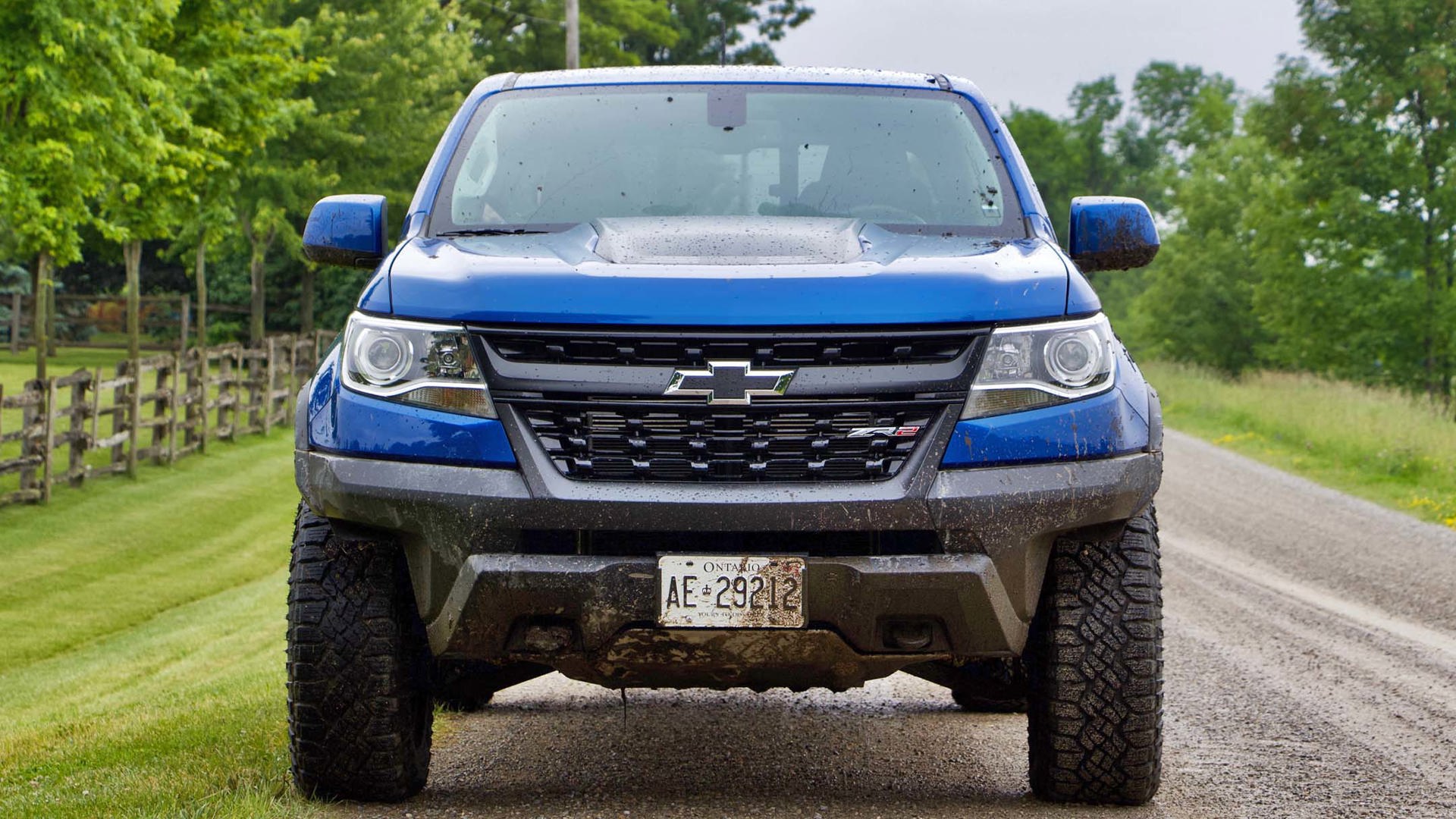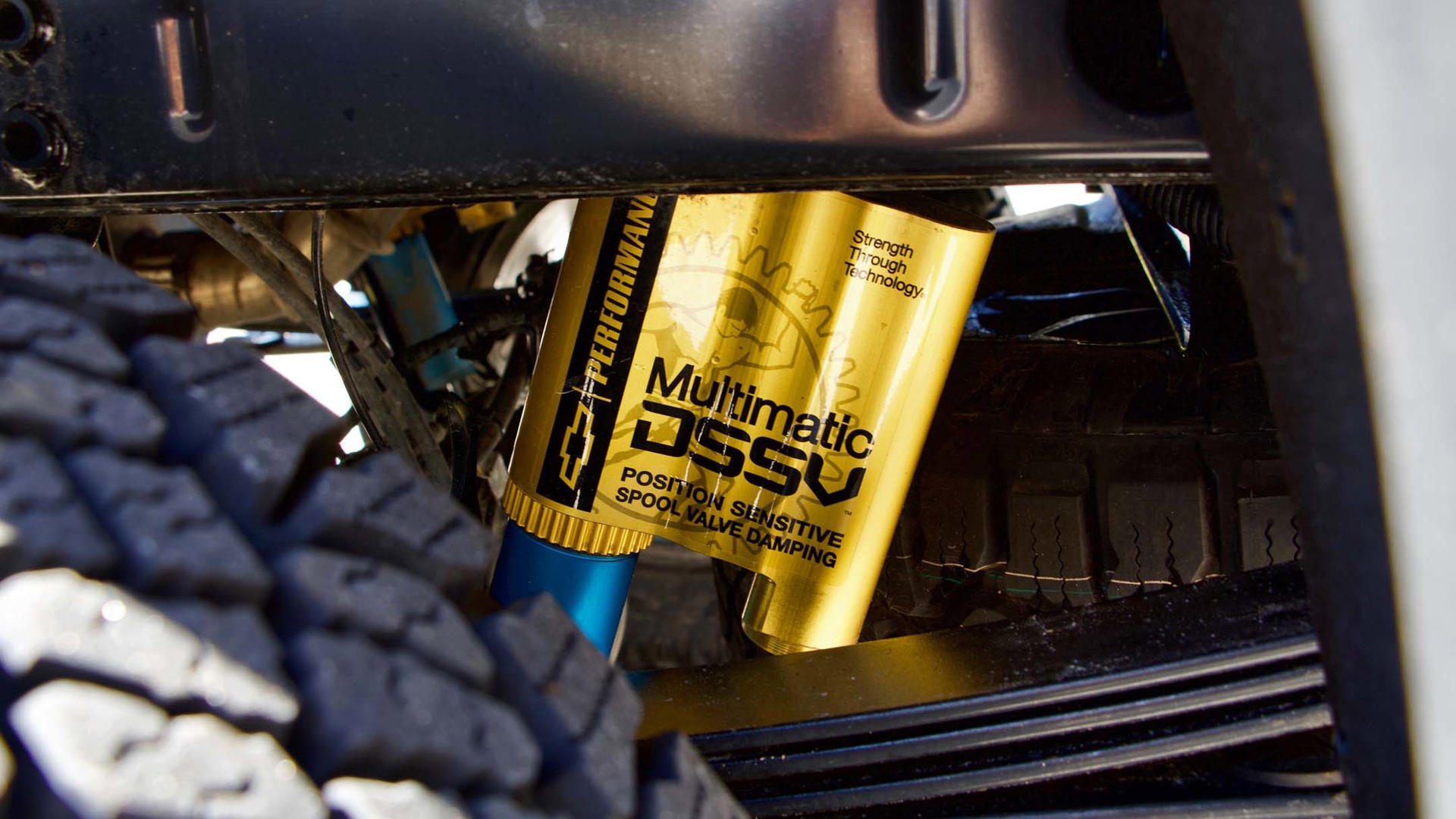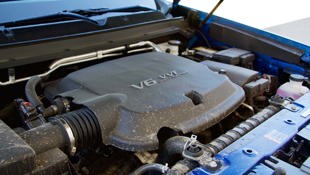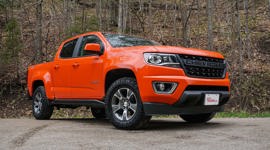 AutoTrader SCORE
AutoTrader SCORE
-
STYLING9/10
-
Safety6/10
-
PRACTICALITY8/10
-
USER-FRIENDLINESS7/10
-
FEATURES9/10
-
POWER8/10
-
COMFORT8/10
-
DRIVING FEEL7/10
-
FUEL ECONOMY6/10
-
VALUE8/10
Truly capable off-road machines are increasingly becoming the domain of aftermarket modification companies. More and more SUVs are crossing over to become minivan-substitute family shuttles, and serious off-road capability is limited to a handful of pickup trucks and SUVs. Not content to let Jeep hog all the glory with its Rubicon Wrangler or Toyota own the small off-roading pickup market with the Tacoma TRD Pro, Chevrolet stepped in with an aggressive off-road package for the revived Colorado, bearing the traditional ZR2 badging.
The power is spot on for this truck, giving it good, strong acceleration that would be plenty for its towing capability, but it’s not so excessive that it gets out of shape.
Customized Right out of the Box
The Colorado and its GMC Canyon twin are already high-riding, tough midsize trucks to begin with, and just stripping off their front air dam and aerodynamic plastic bits improves their chances of off-roading unscathed. The ZR2 is much more than that, of course, and since you already know everything about the Colorado, let’s dive right into what makes the ZR2 so off-road-y.
Of course, it all starts with a lift, by 50 millimetres (2 inches) to be precise, with 90-mm (3.5-inch) wider front and rear tracks to accommodate 31-inch Goodyear Wrangler DuraTrac off-road tires on 17-inch wheels. Under that pretty blue skin, GM engineers didn’t hold back with tweaks to make full use of that added height, reinforcing the suspension with cast-iron control arms and going all out with Multimatic Dynamic Suspensions Spool Valve (DSSV) dampers. Those dampers certainly sound fancy, but why are they good for off-roading?
Well, actually, they are good for both ends of the Colorado ZR2’s needs, enabling better, more durable control of each wheel’s shock absorption and rebound during off-roading, but offering superior comfort and control on paved roads and at highway speeds. To accomplish this, Multimatic adapted their race-proven damper technology that uses unique spool valves inside the damper so that the dampers are soft and cushy when cruising down the highway, but take a firmer set when tackling large obstacles suddenly while off-roading. But they didn’t stop there, and went on to create extra chambers to house the valve for on-road ride and a reservoir (which you can see in the vague form of three chambers in the photos) while fitting the spool valve for extreme off-road impacts in the main shaft.
It’s fascinating stuff if you’re into geeking out about suspension technology or off-road-y bits, but I’m pretty sure I’ve used up my technology deep-dive budget for this review, so let’s get back to the other off-roading gear before we move on to how it actually works in both environments.
Because the ZR2 is serious about taking on the most extreme passable trails and terrain, it offers serious protection for its delicate underparts. Those bars that you see at the side aren’t running boards or steps to get into the ridiculously high cabin, but rather functional rock sliders that protect the body frame while allowing the ZR2 to slide over rocks and obstacles, while the front and rear bumpers have been chopped for better approach and departure angles, and that front bumper isn’t just higher, it also has special cut-outs at the corners for better clearance for the tires when hitting steep obstacles.
Speaking of which, the ZR2 lists a 30 degrees as its approach angle and 23.5 degrees for departure angle, which sound good, but if you’re looking for the best in this category the Tacoma TRD Pro rocks 35 degrees for approach and departure at 25 degrees, so it’s the ditch king on paper. Other ZR2 specs are 23.5 degrees of breakover and 26 inches of fording depth thanks to 8.9 inches of ground clearance.
Rounding out the protective detail are an additional shield for the transfer case and an aluminum skid plate for the radiator and engine oil pan. And if that stance and tires weren’t enough to look the part, Chevy throws in a unique grille and a hood with a power bulge along with numerous ZR2 badges all over.
Power Options
Of course, you won’t get to bash all those plates and crush rocks if you don’t have the power and control to get out of tricky situations. The ZR2 ditches the base 2.5L four-cylinder available in the mortal Colorados, offering up either a Duramax diesel or a beefy 3.6L gasoline V6. The diesel is a 2.8L four-cylinder making 181 horsepower and 369 lb-ft of torque paired with a six-speed automatic. While all that torque sounds delicious, diesel isn’t to everyone’s tastes, so the gasoline option gives up almost 100 lb-ft at 275 lb-ft of torque, but makes up for it with 308 hp paired with an eight-speed automatic.
The power is spot on for this truck, giving it good, strong acceleration that would be plenty for its towing capability, but it’s not so excessive that it gets out of shape. The engine also sounds pretty good when getting going, but at higher speeds it feels and sounds a bit wheezy. The transmission never put a gear wrong, managing the torque smoothly and shifting down quickly when looking for some acceleration.
Despite the number of gears, the gasoline powertrain sucks back fuel at an alarming rate, estimated by NRCan at 14.1 L/100 km overall, while managing 15.0 L/100 km in the city and 13.0 on the highway. Indeed, we saw 15.1 L/100 km on the trip computer at the end of our week, and that included a few highway hauls in addition to our suburban shuttling and detour to play in the mud. The diesel rates much better at 12.5/10.7/11.7, so if you are sensitive to fuel prices, and can afford the extra $4,000 over the 3.6 or higher lease payments, it’s something to consider.
That fuel consumption was also with the truck in its default two-wheel drive or auto for most of the week, but there is also 4-High and 4-Low, plus locking differentials in the front and back for various levels of off-roading.
From the Everyday to the Extraordinary
Living with the Colorado ZR2 was a blast, but not without its drawbacks. As mentioned, the step-in is quite high, and between a bout with lower-back pain and the short height of the door opening, it can be rather awkward to get into your seat. The rock sliders were no help to me because my feet are too big to use them as a reliable step, but my wife and kids managed better than I did. The ZR2’s height also made it less practical to load the pickup or to reach into the bed over the sides, so while it is still pickup practical, lower-riding models make accessing the box much easier if that is a frequently used area in your work.
The model we tested was a Crew Cab short box, so the cabin had plenty of space for the family (we were thankful it wasn’t the Extended Cab like last time I tested a Colorado), and the seats can fold two ways, which is handy if you need to protect your cargo from the elements. The seats themselves were fairly basic and earned few compliments or complaints, but the interior overall seemed a bit outdated except for the 8-inch touchscreen with Chevy MyLink infotainment system, which is a breeze to use and included Apple CarPlay compatibility and a 4G LTE Wi-Fi hotspot.
In casual driving, the ZR2 was surprisingly civilized, those high-end dampers keeping it from bouncing around over every little bump or pothole, and keeping it well composed and steady on the highway. Don’t get me wrong, it still leans over on curves and on ramps, but bumps don’t unsettle it even when the box is empty. Of course, it settles down even more with a load, as we discovered hauling a load of paving stones to the dump (which weighed in at approximately 300 kg), although it didn’t quite tax its full payload rating of 1,100 lb/500 kg, and those dampers are so good that it’s not a significant difference.
Towing capacity for the ZR2 with either engine – whether extended cab with short box (6'2") or Crew Cab with short box (5'2") – is 5,000 lb (2,268 kg), so if towing is your main purpose, the non-ZR2 Crew Cab diesel is the way to go, maxing out at 7,700 lb/3,493 kg in 2WD or 7,600 lb/3,447 kg in 4WD. Payload for most non-ZR2 models is pretty consistent around 1,500 lb/700 kg, no matter the engine, cab or bed size. Although its tow rating isn’t the best of the range, the ZR2 is equipped with standard trailering package with tow/haul mode, 7-pin connector, and integrated trailer brake controller, so it does come ready to tow.
In its natural habitat off paved roads, the ZR2 shines, at least until it is completely covered in mud, and then it’s just pure awesome. The big knobby tires can dig into any surface, the drivetrain puts all that torque to each corner in varying proportions (or equally if the differentials are locked), the low-range gearing allows more precise control of the power, and there’s even hill-descent control to automatically roll down a steep incline at a steady pace.
We didn’t tackle the Rubicon trail, but we got a feel for the truck on an abandoned gravel road, through some ditches and even a rutted mud pit, the kind of terrain you might tackle heading to the oil patch or out on a farm track. The ZR2 never put a foot wrong, and while it didn’t challenge the 4WD system (it was probably excessive for me to have it in 4-Low with both differentials locked), every bit of that ground clearance and approach angle was needed, and those tires proved their worth, easily pulling us out of the muck without any stress.
And at the end of the trip, if you don’t have a wide open field to park it in, it has a back-up camera, which is a great help since the turning circle is quite wide and visibility can be tricky. That camera also comes in handy turning around on a trail, as it would lining up to hitch a trailer.
Capability at a Cost
All this adventure-ready gear and capability comes at a price, but perhaps not as steep as you might think. The 2018 Colorado ZR2 Crew Cab starts at $46,260 for the 3.6L V6 or $50,350 for the 2.8 Duramax diesel, and tack on a $1,795 destination fee for either one. It’s not cheap, but it is competitive, the Toyota Tacoma TRD Pro starting at over $55,000 for the automatic, or the manual at $51,550.
The Colorado ZR2 is a highly specialized tool, and for most needs something more basic would likely get the job done in more affordable fashion. That being said, what impressed me most about the ZR2 is how well it serves when it is not knee-deep in mud or crawling down a gravel incline. The Colorado ZR2 was well behaved on the highway and on trips to the mall, just fine for a family of four with a wide range of modern amenities and just spectacular when you’re busy getting it dirty.
| Engine Displacement | 3.6L |
|---|---|
| Engine Cylinders | V6 |
| Peak Horsepower | 308 hp |
| Peak Torque | 275 lb-ft |
| Fuel Economy | 15.0/13.0/14.1 L/100 km city/hwy/comb |
| Cargo Space | 1,567 mm (61.7 in) bed; 499 kg/1,100 lb payload |
| Model Tested | 2018 Chevrolet Colorado ZR2 Crew Cab Short Box |
| Base Price | $46,260 |
| A/C Tax | $100 |
| Destination Fee | $1,795 |
| Price as Tested | $52,805 |
|
Optional Equipment
$4,650 – Performance Cat-back exhaust $1,745; Premium Interior Package $1,140; Bose Premium Speakers $685; Kinetic Blue Metallic $495; Cargo area lamp $325; Black Bowtie logos $260
|
|


















































